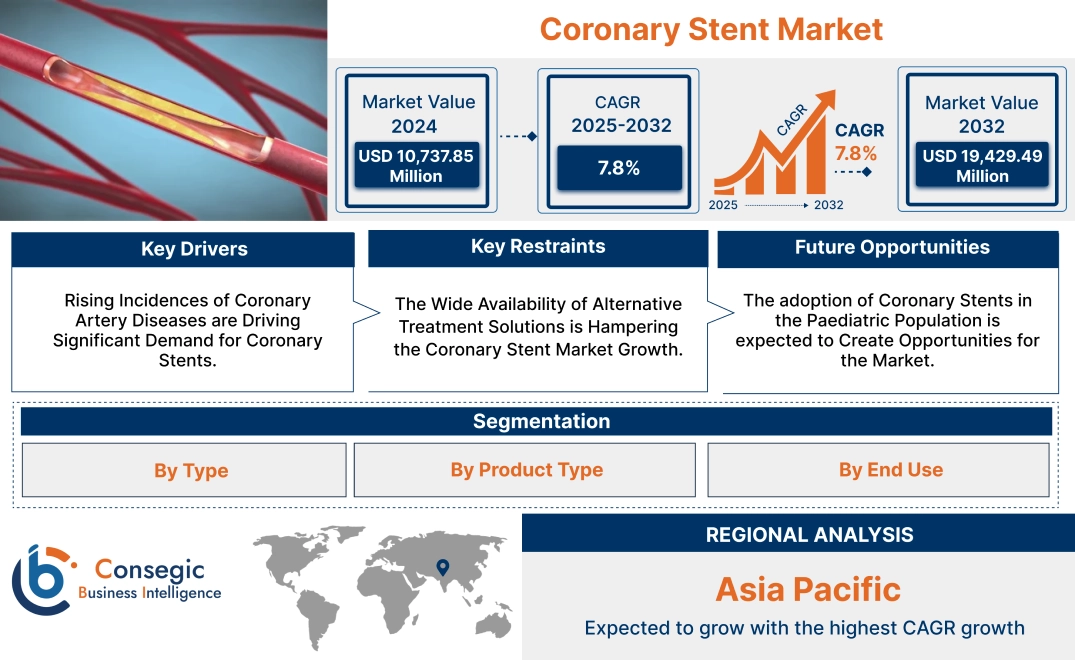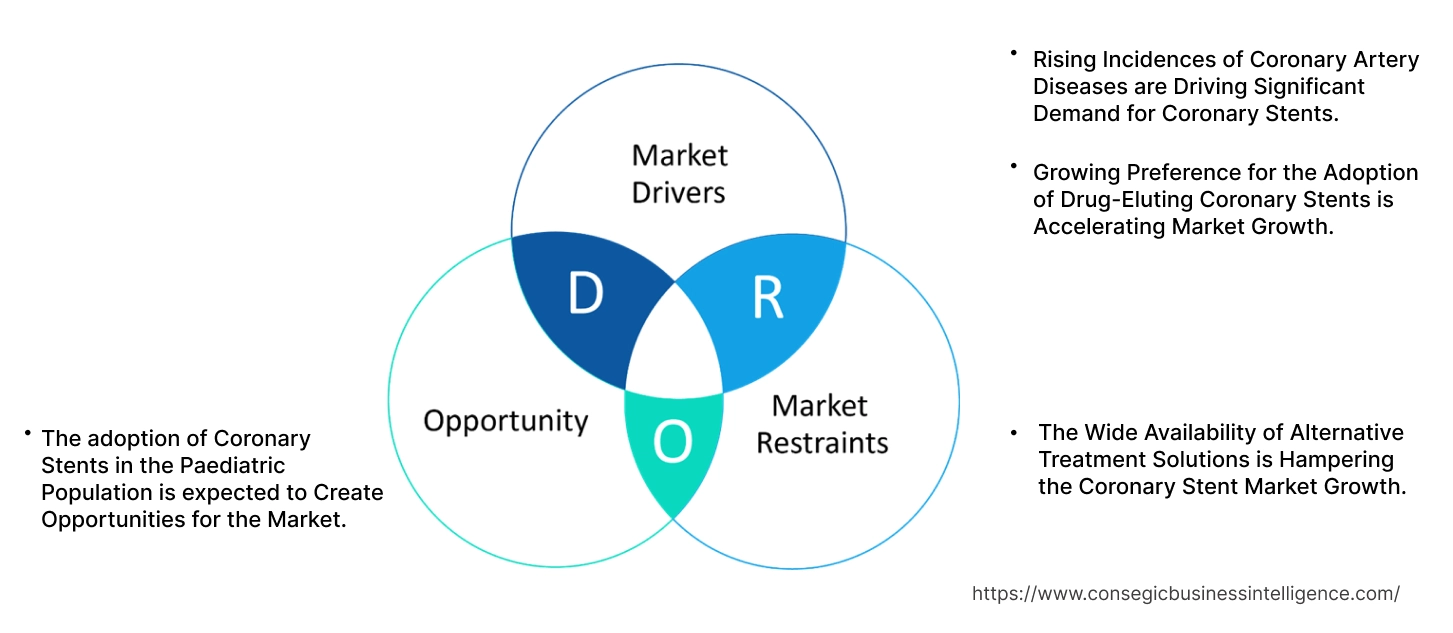Coronary Stent Market Size:
Coronary Stent Market size is growing with a CAGR of 7.8% during the forecast period (2025-2032), and the market is projected to be valued at USD 19,429.49 Million by 2032 from USD 10,737.85 Million in 2024.
Coronary Stent Market Scope & Overview:
Coronary stents (CS) are expandable tubular metallic devices which are introduced into the coronary arteries that demonstrate stenosis due to an underlying atherosclerosis disease. These stents are typically made from stainless steel, cobalt‑chromium alloys, nickel‑titanium alloy, platinum, and tantalum alloys.
These stents are available in several types including bare metal stents, drug-eluting stents, bioresorbable stents, and others. Bare metal stents, also known as uncoated stents, are the most basic type of stent whereas drug-eluting stents are coated with medication that is slowly released to prevent restenosis. A bioresorbable scaffold system is a new type of stent made of a biodegradable material, such as polylactide that gradually dissolve and are absorbed by the body. These stents are employed through two types of deployment techniques including self-expansion and ballon-expansion. Stents offer several significant benefits, including improved blood flow to the heart muscle, relieving chest pain, and reducing the risk of heart attack.
How is AI Transforming the Coronary Stent Market?
Coronary stents (CS) are expandable tubular metallic devices which are introduced into the coronary arteries that demonstrate stenosis due to an underlying atherosclerosis disease. These stents are typically made from stainless steel, cobalt‑chromium alloys, nickel‑titanium alloy, platinum, and tantalum alloys.
These stents are available in several types including bare metal stents, drug-eluting stents, bioresorbable stents, and others. Bare metal stents, also known as uncoated stents, are the most basic type of stent whereas drug-eluting stents are coated with medication that is slowly released to prevent restenosis. A bioresorbable scaffold system is a new type of stent made of a biodegradable material, such as polylactide that gradually dissolve and are absorbed by the body. These stents are employed through two types of deployment techniques including self-expansion and ballon-expansion. Stents offer several significant benefits, including improved blood flow to the heart muscle, relieving chest pain, and reducing the risk of heart attack.
Key Drivers:
Rising Incidences of Coronary Artery Diseases are Driving Significant Demand for Coronary Stents.
The surging prevalence of coronary artery disorders, also known as coronary heart disease or ischemic heart disease, is one of the prominent factors fueling the adoption of coronary stents. The underlying cause of coronary artery disease is atherosclerosis, which is characterized by the formation of luminal cholesterol plaques and other substances. These plaques build up in the walls of the coronary arteries that supply blood to the heart and other parts of the body. Plaque buildup causes the inside of the arteries to narrow over time, which partially blocks the blood flow. To procure this, a procedure called coronary angioplasty is performed to widen blocked or narrowed coronary arteries. In this procedure, stents are utilized to treat an aneurysm, which is a bulge in the wall of an artery and allows the blood to move freely. The rising incidences of coronary artery diseases are propelling the demand for stenting procedures.
- For instance, according to the data published by the Centers for Disease Control and Prevention in October 2024, coronary heart disease, recognized as the most prevalent form of heart disease, resulted in 371,506 deaths in the United States in 2022. It is estimated that approximately 5% of adults aged 20 and older, or roughly 1 in 20 individuals, are affected by coronary artery disease (CAD). Furthermore, in 2022, approximately 20% of cardiovascular disease fatalities occurred among adults younger than 65 years of age.
As a result, an unprecedented rise in coronary artery disease incidence is boosting the requirements for coronary stents for effective treatment.
Growing Preference for the Adoption of Drug-Eluting Coronary Stents is Accelerating Market Growth.
Drug-eluting stents (DES) have advanced the treatment of coronary artery disease by addressing the limitations of bare metal stents. Drug-eluting stents serve as novel implantable devices that release single or multiple bioactive agents into blood vessels after implantation. The stent is coated with a drug and placed in an artery to treat coronary artery disease. They incorporate a variety of therapeutic agents including sirolimus, everolimus, and others to prevent restenosis. These antiproliferative drugs stop vascular smooth muscle cell proliferation and thus, neointimal hyperplasia.
Drug-eluting stents offer significant advantages in the treatment of coronary artery disease. By incorporating a drug-eluting coating, DES significantly reduces the risk of restenosis, which is the re-narrowing of the artery. This reduction in restenosis leads to improved patient outcomes. One major purpose of drug-eluting stents is to limit neointimal hyperplasia. Furthermore, DES is designed to provide long-term benefits, often lasting for several years, reducing the need for frequent procedures and improving overall patient care. Hence, the overall benefits provided by drug-eluting stents are resulting in an increase in their adoption.
- For instance, in May 2024, Abbott, the global healthcare company, announced the launch of XIENCE Sierra Everolimus Eluting Coronary Stent System in India. XIENCE Sierra is one of the latest generations of stents in the XIENCE family, now available to people suffering from blocked coronary arteries in coronary artery disease.
Overall, drug-eluting patterns, which involve the controlled release of therapeutic agents from the stent surface, have significantly enhanced the effectiveness of coronary stents.
Key Restraints:
The Wide Availability of Alternative Treatment Solutions is Hampering the Coronary Stent Market Growth.
The wide availability of substitute treatment options is significantly hindering the coronary stent market expansion. This factor is driven by the increasing preference for alternatives including medications, drug-eluting balloons, angioplasty, bypass surgery, and atherectomy among others provide prominent solutions for stenosis in coronary arteries. Medications such as antiplatelet agents and statins offer non-invasive approaches to managing coronary arterial disease (CAD). These medications help to reduce the risk of blood clots and improve blood flow to the affected arteries. Drug-eluting balloons have emerged as a less invasive alternative to stents, combining the benefits of angioplasty with drug-eluting technology. DEBs offer several advantages a reduced risk of major adverse cardiac events, a decreased need for dual antiplatelet therapy, the elimination of stent thrombosis risk, targeted drug distribution, and the ability to be used in complex lesions.
Angioplasty is a minimally invasive procedure that opens blocked or narrowed arteries in limbs. Additionally, Bypass surgery continues to be a valuable treatment for severe CAD, involving the creation of a new pathway for blood to bypass the blocked artery. The availability of alternative treatments provides patients and healthcare providers with a broader range of options to address coronary arterial disease. Furthermore, these substitutes don’t leave permanent implants in the vessel. While stents remain an effective and valuable tool in the management of CAD, the increasing developments in alternative approaches have contributed to a more competitive landscape potentially restraining the coronary stent market expansion.
Future Opportunities :
The adoption of Coronary Stents in the Paediatric Population is expected to Create Opportunities for the Market.
The adoption of coronary stents in the pediatric population has the potential to create significant coronary stent market opportunities. Children have smaller coronary arteries, making access and stent delivery more technically demanding. For the developmental stages of children, the stent must accommodate this growth without causing complications like in-stent restenosis or vessel obstruction. Expanding the addressable market to include pediatric patients, necessitates the development of specialized stents tailored to their unique physiological and anatomical characteristics. Furthermore, the growing need for safe and effective stents for pediatric use will create a new market segment for medical device companies, supporting research and development in this area.
- For instance, in August 2024, the Food and Drug Administration approved first-of-its-kind cardiac stent for babies based on data from a national clinical trial led by Children’s Hospital Los Angeles. The stent, called the Minima, is developed for neonates, infants, and young children with aortic coarctation. This approval signifies achievement in pediatric cardiology, opening new avenues for the treatment of congenital heart defects and driving further innovation in the coronary stent market trend for this vulnerable patient population.
Thus, the successful application of stents in pediatric patients holds significant potential for the coronary stent market growth.
Coronary Stent Market Segmental Analysis :
By Type:
Based on type, the market is categorized into bare metal stent, drug-eluting stent, bioresorbable stent, and others.
Trends in the Type:
- Increasing interest in developing stents using novel materials, such as polymers and biocompatible metals, with improved biocompatibility and reduced risk of complications.
The drug-eluting stent segment accounted for the largest market share in 2024.
- Drug-eluting stents (DES) are a specialized type of stent that incorporates a drug-releasing coating. This coating slowly releases medication into the artery, inhibiting tissue growth and reducing the risk of restenosis, which is the re-narrowing of the artery after treatment.
- Additionally, this coating inhibits the proliferation of smooth muscle cells and reduces the inflammation in the artery, further promoting healing and preventing re-stenosis.
- DES comprises three primary components: a metallic stent platform, an active pharmacological agent, and a carrier vehicle. First-generation DES, such as sirolimus-eluting stents and paclitaxel-eluting stents, have been widely utilized. Subsequent generations of DES have incorporated more biocompatible and durable polymer coatings to enhance their safety and efficacy.
- In addition to this, advancements and developments in drug-eluting stents are boosting the adoption and demand for CS in surgical centers boosting the segment trajectory.
- For instance, in August 2022, Medtronic, a medical technology company launched its newest drug-eluting coronary stent, the Onyx Frontier drug-eluting stent with approval from the U.S. Food and Drug Administration. The Onyx Frontier DES offers an innovative delivery system with an enhanced delivery designed to improve deliverability and increase acute performance in the most challenging cases.
- As a result, as per analysis, the advantages of drug-eluting stents with increased safety for patients are driving the segment trajectory.
The bioresorbable segment is expected to grow at the fastest CAGR over the forecast period.
- Bioresorbable stents are a newer type of stent designed to dissolve gradually over time. These stents are resorbed for over 6 months to 2 years, alleviating long-term chronic inflammation and enabling endothelial regeneration. They are made from materials such as polylactide which breaks down over time.
- Bioresorbable stents offer several advantages over traditional stents. One of the most significant benefits is their ability to reduce the risk of in-stent restenosis, a common complication that occurs with traditional stents. By gradually dissolving or degrading over time, these stents minimize the presence of a foreign body in the artery, potentially leading to improved long-term outcomes. This temporary nature also provides patients with enhanced comfort as the stent eventually disappears.
- As a result, as per analysis, bioresorbable stents offer a promising solution for treating coronary artery diseases, as they provide temporary support, minimize the risk of in-stent restenosis, and potentially reduce complications associated with traditional stents.
By Product Type:
Based on product type, the market is bifurcated into self-expandable and balloon-expandable.
Trends in Product Type:
- The development of self-expanding stents tailored to individual patient needs, such as those with specific vessel anatomies or clinical characteristics, is an area of growing interest.
The balloon expandable segment accounted for the largest market share in the year 2024.
- Balloon expandable stent is inflated with a balloon and then the balloon is deflated and removed.
- The mechanism of balloon-expandable stents involves a catheter equipped with a deflated balloon at its tip. This catheter is carefully positioned at the site of the arterial obstruction. Upon reaching the target location, the balloon is inflated, causing both the balloon and the stent to expand simultaneously. This dilation exerts pressure on the arterial walls, opening the narrowed or blocked segment and restoring blood flow.
- The precise control afforded by balloon-expandable stents during this process is a key advantage. Additionally, they present high radial strength and stiffness that provide high radial force to effectively open a blocked coronary artery.
- For instance, in July 2022, Shanghai MicroPort Medical (Group) Co., Ltd. announced that its Firehawk Pro Coronary Rapamycin Target Eluting Stent System received approval from the Chinese National Medical Products Administration (NMPA). This innovative system comprises a balloon-expandable coronary stent, a groove-binding single-sided drug coating, and a dedicated delivery system.
- Overall, as per analysis, durable construction and precise inflation of balloon-expandable stents mechanism make them a valuable tool in interventional procedures. By effectively opening blocked arteries balloon-expandable stents contribute to improved patient outcomes.
The self-expandable segment is expected to grow at the fastest CAGR over the forecast period.
- Self-expanding stents are innovative vascular devices designed to maintain luminal patency in various medical conditions. These stents are mainly made from materials such as nitinol, or nickel-titanium alloy among others for their unique shape memory and properties.
- Self-expandable stents expand automatically upon deployment from a delivery catheter. This characteristic allows them to adapt to the vessel’s anatomy, making them useful in areas with complex geometries. The deployment process involves positioning the stent at the target site and then withdrawing the delivery system, allowing the stent to expand and conform to the vessel’s wall.
- Self-expanding stents offer reduced vessel wall trauma during implantation due to their gradual dilation compared to the forceful inflation of balloon-expandable stents. They also achieve better contact with the vessel wall, potentially leading to more stable stent placement and reduced complications.
- Furthermore, their gradual dilation results in a more gentle and controlled widening of the stenotic segment, potentially minimizing acute complications. SES also conforms more readily to the complex anatomy of the vessel, potentially improving stent placement and long-term outcomes.
- Overall,self-expanding stents represent a significant advancement in the field of interventional medicine, offering several potential advantages over traditional balloon-expandable stents.
By End-User:
Based on end use, the market is categorized into hospitals, cardiology centers, and ambulatory surgical centers.
Trends in the End Use:
- Increasing focus on value-based care is a trend in driving demand for high-quality, cost-effective stents with proven clinical outcomes.
- Growing adoption of advanced technologies, such as imaging and robotic-assisted procedures across hospitals to improve the accuracy and efficiency of stent implantation procedures.
The hospitals segment accounted for the largest coronary stent market share of 48.55% in the year 2024.
- Hospitals remain the primary end-users for coronary stents, driving a significant portion of the market. This dominance stems from their comprehensive infrastructure, dedicated cardiac care units, and access to a wide array of interventional cardiology procedures.
- Hospitals typically perform a high volume of CS implantations, catering to a diverse patient population with varying degrees of cardiac conditions, including complex cases such as patients with multiple stenoses, calcified lesions, and chronic total occlusions, necessitating the utilization of advanced stent technologies.
- The increasing emphasis on value-based care models is driving hospitals to prioritize the use of high-quality, cost-effective stents with proven clinical outcomes, incentivizing the adoption of stents that minimize complications, reduce readmissions, and enhance long-term patient outcomes.
- For instance, in September 2024, the cardiac catheterization laboratory at HCA Florida Brandon Hospital started treating patients with a novel drug-coated balloon catheter designed to address in-stent restenosis. In-stent restenosis refers to the re-narrowing of a coronary artery that has previously been treated with a stent.
- Overall, as per analysis, hospitals hold a pivotal position in the coronary stent market analysis, prioritizing high-quality and cost-effective solutions to enhance patient outcomes and adapt to evolving healthcare models.
The ambulatory surgical centers segment is expected to grow at the fastest CAGR over the forecast period.
- Ambulatory surgery centers, or ASCs, are modern healthcare facilities focused on providing same-day surgical care, including diagnostic and preventive procedures.
- One of the primary advantages of performing stenting in ASCs is the reduced length of hospital stay. Most patients expect to be discharged within hours after their procedure. This rapid discharge is not only beneficial for patients but also alleviates pressure on hospital resources, allowing facilities to manage more cases efficiently.
- Moreover, ASCs often have lower operational costs compared to traditional hospital settings, which translates into cost savings for both patients and insurers.
- Additionally, coatings are crucial for restoring classic and vintage vehicles to their original condition. By addressing these various needs, these coatings help to maintain the value and appeal of vehicles throughout their lifespan.
- Overall, the use of coronary stents in ambulatory surgical centers represents a significant advancement in vascular intervention, providing an effective treatment option for patients while promoting efficiency within healthcare systems.
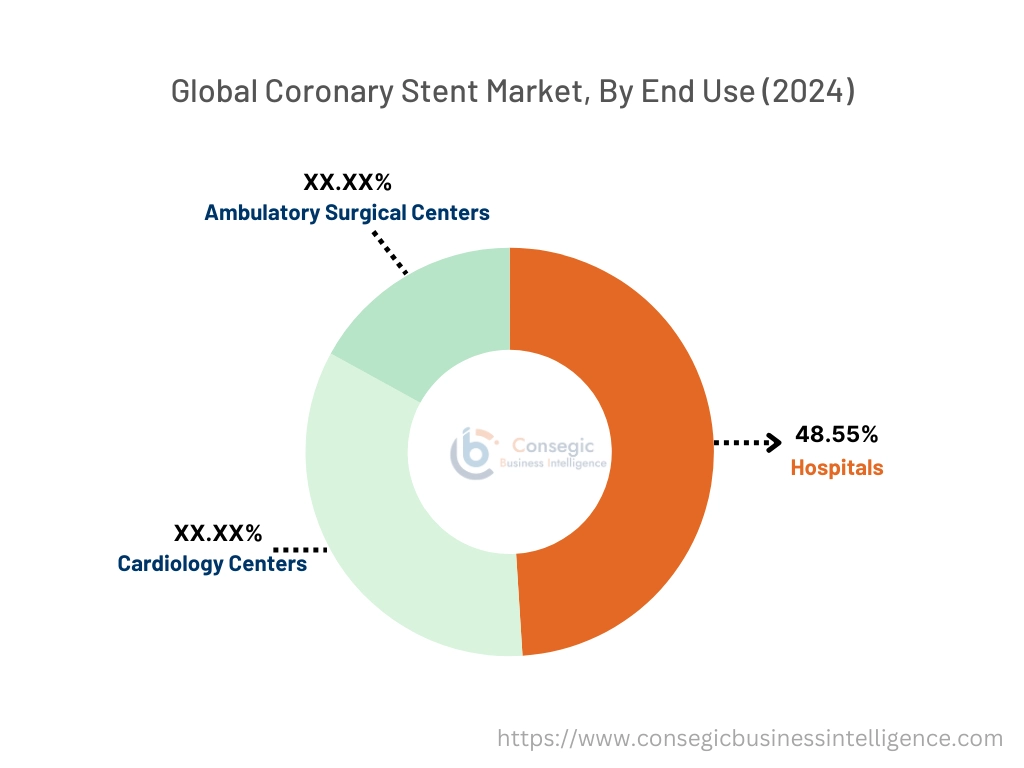
Regional Analysis:
The regional segment includes North America, Europe, Asia Pacific, the Middle East and Africa, and Latin America.
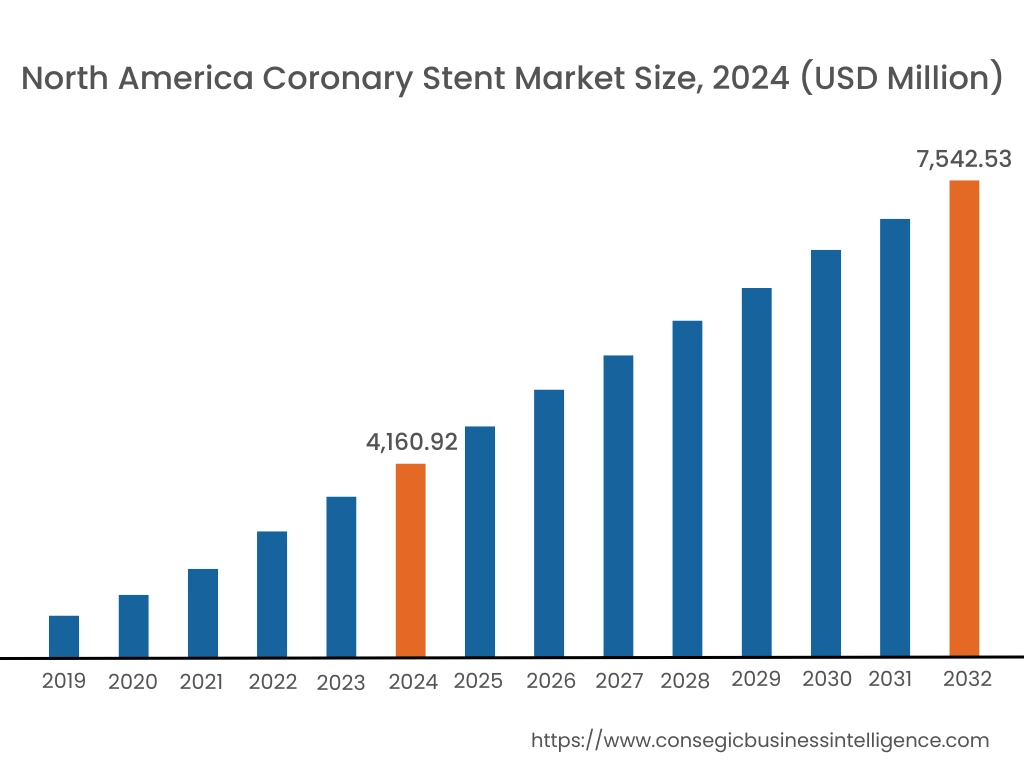
In 2024, North America accounted for the highest market share at 38.75% and was valued at USD 4,160.92 Million and is expected to reach USD 7,542.53 Million in 2032. In North America, the U.S. accounted for the highest market share of 77.23% during the base year of 2024. North America dominates the global coronary stent market, attributed to several factors including a high prevalence of cardiovascular diseases, a well-developed healthcare industry infrastructure with advanced medical facilities and skilled healthcare professionals, and a strong presence of leading medical device companies driving innovation. Additionally, high healthcare expenditure in the region allows for greater access to advanced medical treatments, including coronary stenting procedures. Furthermore, North America is at the forefront of medical research and development, with significant investments in developing innovative stent technologies.
- For instance, in January 2022, the Cardiovascular Institute of the South (CIS) in Houma, Louisiana, performed the first-in-the-nation implantation of the Orsiro Mission Coronary Artery Drug Eluting Stent (DES) by BIOTRONIK, Inc. in an ambulatory surgery setting. This procedure was conducted to treat coronary artery disease.
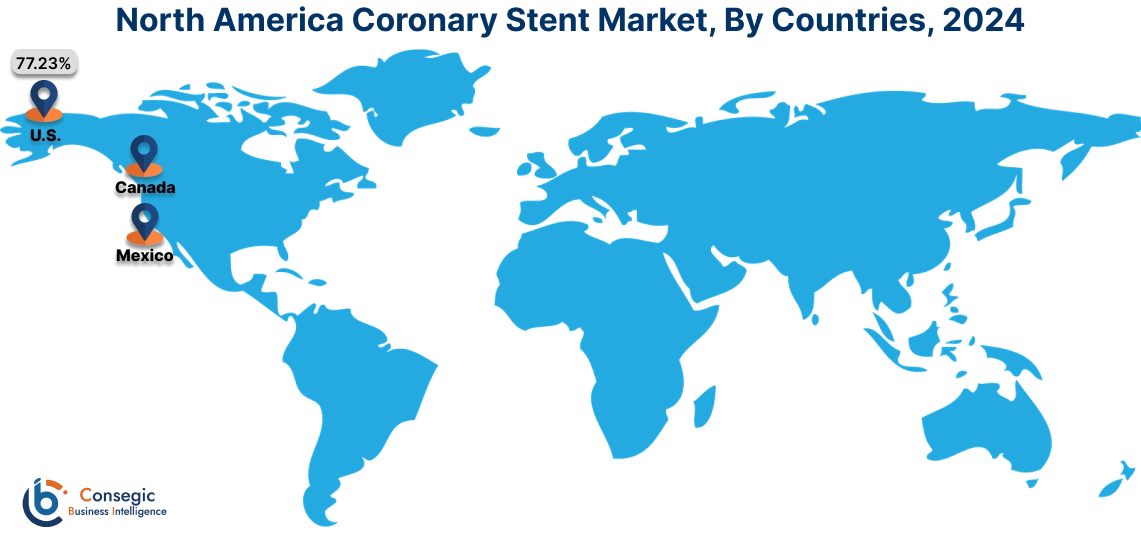
The increasing emphasis on value-based care models across the region is driving the adoption of cost-effective and high-quality stents with proven clinical outcomes, incentivizing the development and adoption of stents that minimize complications, reduce readmissions, and improve long-term patient outcomes. Moreover, favorable reimbursement policies from payers, such as insurance companies and government programs, play a significant role in the adoption and utilization of coronary stents in the North American market. The combination of the aforementioned factors and trends is driving a substantial trajectory in the North American market.
Asia Pacific is experiencing the fastest growth with a CAGR of 8.3% over the forecast period. Several key factors including a rapidly aging population, a rising prevalence of cardiovascular diseases attributed to changing lifestyles, and increasing healthcare expenditure contribute to coronary stent market demand. Growing economies and rising disposable incomes are facilitating greater access to advanced medical treatments, such as stent procedures. Moreover, substantial investments are being made in developing healthcare infrastructure, encompassing the establishment of specialized cardiac centers and the training of skilled healthcare professionals. Additionally, government initiatives aimed at improving healthcare access and affordability are contributing to the trajectory of the coronary stent market trend within the region.
Europe presents a significant contribution to the coronary stent market analysis. The European coronary stent market is considered a mature market characterized by well-established healthcare systems with advanced infrastructure, skilled professionals, and high-quality patient care standards. Europe is renowned for its focus on research and development in the medical device industry, with significant investments in innovative stent technologies such as bioresorbable stents and drug-eluting stents with improved drug delivery systems. Healthcare systems across Europe have implemented cost-containment measures to ensure the sustainability of healthcare delivery, driving the requirement for cost-effective and high-value stents with proven clinical outcomes. Healthcare systems in Europe prioritize patient outcomes, focusing on improving patient quality of life and driving the need for stents with superior clinical performance and safety profiles.
The Middle East and Africa (MEA) region is witnessing notable coronary stent market demand characterized by significant potential. This growth is driven by several factors, including the rising prevalence of cardiovascular diseases and the growing prevalence of risk factors like diabetes and obesity. Economic surges in many countries within the region are leading to increased healthcare expenditure, enabling greater access to advanced medical treatments, including stent procedures. Efforts are underway to improve healthcare infrastructure across many countries in the region, including investments in developing specialized cardiac centers, training skilled healthcare professionals, and enhancing access to advanced medical technologies. Furthermore, countries with emerging economies within the region, such as the Gulf Cooperation Council (GCC) countries, are witnessing increased development of advanced healthcare services further creating coronary stent market opportunities in the MEA.
Latin America is an emerging region in the coronary stent market share, with significant potential for innovation. The region is experiencing a significant rise in the prevalence of cardiovascular diseases, including coronary artery disease, driven by factors such as changing lifestyles and the growing prevalence of risk factors like diabetes, obesity, and hypertension. Additionally, there is a general trend towards increased investment in healthcare across Latin American countries. This is driven by economic growth, government initiatives, and increasing awareness about the importance of preventive healthcare. These factors collectively present a promising factor for healthcare providers and medical device companies’ manufacturers to develop and deliver innovative coronary stents in Latin America.
Top Key Players and Market Share Insights:
The Coronary Stent market is highly competitive with major players providing precise products to the national and international markets. Key players are adopting several strategies in research and development (R&D) and product innovation to hold a strong position in the global Coronary Stent market. Key players in the Coronary Stent industry include-
- Boston Scientific Corporation (U.S.)
- Medtronic (Ireland)
- MicroPort Scientific Corporation (China)
- Cook (U.S.)
- amg International (Germany)
- Abbott. (U.S.)
- BD (U.S.)
- Braun SE (Germany)
- Terumo Corporation (Japan)
- Biosensors International Group, Ltd. (Singapore)
Recent Industry Developments :
Product Launch:
- In May 2024, Abbott, the global healthcare company, announced the launch of the XIENCE Sierra Everolimus Eluting Coronary Stent System in India. XIENCE Sierra is now available to people suffering from blocked coronary arteries.
- In August 2022, Medtronic, a medical technology company launched its newest drug-eluting coronary stent, the Onyx Frontier drug-eluting stent (DES) with approval from USFDA. The Onyx Frontier DES offers an innovative delivery system with an enhanced delivery designed to improve deliverability and increase acute performance in the most challenging cases.
Coronary Stent Market Report Insights :
| Report Attributes | Report Details |
| Study Timeline | 2019-2032 |
| Market Size in 2032 | USD 19,429.49 Million |
| CAGR (2025-2032) | 7.8% |
| By Type |
|
| By Product Type |
|
| By End-User |
|
| By Region |
|
| Key Players |
|
| North America | U.S. Canada Mexico |
| Europe | U.K. Germany France Spain Italy Russia Benelux Rest of Europe |
| APAC | China South Korea Japan India Australia ASEAN Rest of Asia-Pacific |
| Middle East and Africa | GCC Turkey South Africa Rest of MEA |
| LATAM | Brazil Argentina Chile Rest of LATAM |
| Report Coverage |
|
Key Questions Answered in the Report
How big is the Coronary Stent market? +
In 2024, the Coronary Stent market is USD 10,737.85 Million.
Which is the fastest-growing region in the Coronary Stent market? +
Asia Pacific is the fastest-growing region in the Coronary Stent market.
What specific segmentation details are covered in the Coronary Stent market? +
Type, Product Type, and End Use segmentation details are covered in the Coronary Stent market.
Who are the major players in the Coronary Stent market? +
AkzoNobel (Netherlands), Birla Carbon (India), and The Sherwin-Williams Company (U.S.) are some of the major players in the market.
